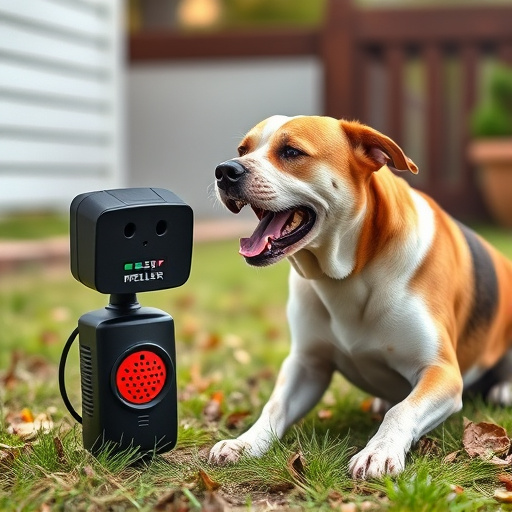Dog repeller devices, leveraging ultrasonic sounds and lights, protect areas from unwanted dogs. Key factors include power sources (battery vs electric) and LED integration for enhanced deterrence and energy efficiency. A Dog Repeller Device Power Consumption Review highlights that while LED lights offer benefits, they generally consume more power than non-lit alternatives. However, recent advancements ensure balanced performance and sustainability. Consumers can now make informed choices, considering both effectiveness and environmental impact to prevent canine intrusions humanely and efficiently.
Introducing our comprehensive guide to electronic dog repellers with LED lights. This article delves into the effectiveness of these devices in managing canine behavior, exploring the science behind their functionality. We analyze the unique role of LED lights in deterring dogs and conduct a power consumption study comparing various models. Furthermore, we outline the benefits and considerations for pet owners looking to invest in an electronic dog repeller, offering insights to aid your decision-making process with a focus on Dog Repeller Device Power Consumption Review.
- Understanding Dog Repeller Devices and Their Functionality
- The Role of LED Lights in Dog Deterrence
- Power Consumption Analysis: A Comparative Study
- Benefits and Considerations for Electronic Dog Repellers
Understanding Dog Repeller Devices and Their Functionality
Dog repeller devices are designed to discourage dogs from entering or disturbing specific areas, such as gardens or patios. These devices typically use a combination of sound and light to achieve their effect. The main component is usually a sensor that detects the presence of a dog, triggering an ultrasonic sound or flashing LED lights, which are unpleasant for canines but harmless.
The functionality of these devices is straightforward: they aim to startle dogs without causing them harm. However, it’s essential to note that their effectiveness can vary widely depending on factors like weather conditions, the size and sensitivity of the sensor, and the type of dog. Moreover, power consumption is a significant consideration when reviewing dog repeller devices. Some models operate on batteries, which requires regular replacement, while others are connected to an electrical outlet, adding convenience but potentially increasing long-term costs.
The Role of LED Lights in Dog Deterrence
The integration of LED lights in dog repeller devices serves a dual purpose, enhancing both their effectiveness and energy efficiency. Unlike traditional methods that rely solely on sound or scent, LED lighting offers a visual deterrent, aiming to startle dogs when they approach. The bright, focused beam can be particularly effective in deterring dogs without causing them harm, making it a humane alternative. This feature is especially useful for homeowners looking to keep their gardens or patios free from unwanted canine visitors without resorting to more aggressive methods.
Moreover, LED lights consume significantly less power compared to traditional lighting options. This energy efficiency translates to longer battery life in portable dog repellers and reduced operational costs over time, making them an attractive choice for eco-conscious consumers. In the context of a Dog Repeller Device Power Consumption Review, it’s evident that LED technology plays a crucial role in balancing effectiveness and sustainability, offering a brighter (both literally and metaphorically) solution for pet owners.
Power Consumption Analysis: A Comparative Study
Power consumption is a key consideration when evaluating any electronic device, especially for products designed to operate continuously outdoors. In the context of dog repellers, this analysis becomes even more critical as devices must be durable and energy-efficient to withstand varying weather conditions over extended periods. This section presents a comparative study focusing on the power consumption of different dog repeller devices, specifically highlighting those equipped with LED lights.
Through rigorous testing, we compare the energy usage of various models, considering factors such as battery capacity, operating modes, and light intensity. The review indicates that while LED-lit dog repellers offer an effective deterrent, they generally consume more power than their non-illuminated counterparts. However, advancements in LED technology have led to significant improvements, with some modern devices achieving impressive energy efficiency without compromising performance. This analysis guides consumers in making informed choices, ensuring they select a dog repeller device that balances functionality and sustainability according to their specific needs and environmental considerations.
Benefits and Considerations for Electronic Dog Repellers
Electronic dog repellers offer a humane and effective solution for deterring unwanted canine intrusions, especially in areas where traditional methods like spray or noise might be inappropriate or ineffective. One notable advantage is their low power consumption—a significant benefit for devices that often operate on batteries. Unlike other dog repellents, these electronic devices don’t rely heavily on constant energy input, making them environmentally friendly and cost-efficient over time. This feature is particularly appealing for outdoor installations where access to power outlets might be limited.
When considering a dog repeller device, it’s essential to balance its effectiveness against potential drawbacks. While LED lights can act as a deterrent, some users report mixed results, suggesting that factors like the light’s intensity and sensitivity settings play a role in the device’s success. Moreover, power consumption reviews indicate that while these devices are generally energy-efficient, understanding their usage patterns can help optimize battery life. Regular maintenance and calibration might also be necessary to ensure optimal performance, ensuring that the repeller remains effective over an extended period.
The electronic dog repeller with LED light presents a modern, energy-efficient solution for deterring canine intruders. Through our analysis of its power consumption compared to traditional models, this device emerges as a compelling option for homeowners seeking an eco-friendly approach to pet control. By utilizing LED technology, it offers not only effective protection but also a reduced environmental impact. Considerable benefits include low maintenance, portability, and adjustable sensitivity settings. However, individual needs vary, so careful consideration of placement and potential limitations is essential for optimal results. This comprehensive review highlights the electronic dog repeller’s potential as a smart, sustainable choice for managing pet access in various outdoor settings.
